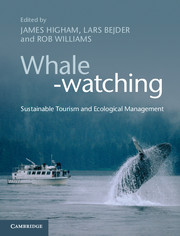Book contents
- Frontmatter
- Dedication
- Contents
- Acknowledgements
- List of contributors
- List of abbreviations
- 1 Tourism, cetaceans and sustainable development
- Part I The historical and contemporary contexts
- Part II Human dimensions of whale-watching
- Part III Ecological dimensions of whale-watching
- Part IV Sustainable management: insights and issues
- 18 The socioeconomic, educational and legal aspects of whale-watching
- 19 Vigilance, resilience and failures of science and management
- 20 Insights from agent-based modelling to simulate whale-watching tours
- 21 Cetacean-watching in developing countries
- 22 Kaikoura (New Zealand)
- 23 Management of dusky dolphin tourism at bKaikoura, New Zealand
- 24 Save the whales Part II
- 25 Time to rethink
- Index
- Plate Section
- References
25 - Time to rethink
Fostering the nascent ‘sustainability paradigm’
from Part IV - Sustainable management: insights and issues
Published online by Cambridge University Press: 05 April 2014
- Frontmatter
- Dedication
- Contents
- Acknowledgements
- List of contributors
- List of abbreviations
- 1 Tourism, cetaceans and sustainable development
- Part I The historical and contemporary contexts
- Part II Human dimensions of whale-watching
- Part III Ecological dimensions of whale-watching
- Part IV Sustainable management: insights and issues
- 18 The socioeconomic, educational and legal aspects of whale-watching
- 19 Vigilance, resilience and failures of science and management
- 20 Insights from agent-based modelling to simulate whale-watching tours
- 21 Cetacean-watching in developing countries
- 22 Kaikoura (New Zealand)
- 23 Management of dusky dolphin tourism at bKaikoura, New Zealand
- 24 Save the whales Part II
- 25 Time to rethink
- Index
- Plate Section
- References
Summary
This book addresses human interactions with cetaceans in the wild, at the heart of which lies the considerable challenge of sustainable management. The urgency of this subject arises from spectacular growth in demand and widespread evidence of unsustainable management of tourist interactions with cetaceans. The foregoing chapters serve to highlight the complex interplay of the macro- (global), meso- (national/regional) and micro-level (local/site-specific) policy, planning and management settings. The dynamic nature of these contexts combined with the urgent need for integrated and adaptive management approaches are most evident (Higham et al., 2009). Given the current failing of the long-term sustainable management of many whale-watching activities, a new whale-watching paradigm is clearly required (Lusseau et al., 2013). Any such paradigm must be informed by change at three spatial scales of analysis (Higham et al., 2009.
While attending to the management of tourist interactions with cetaceans, it is necessary to understand the policy, planning and management inputs which take place at the macro- (global), meso- (national) and micro (local–regional) levels at specific sites in different parts of the world (Figure 25.1). The macro-level context is characterized by growing concerns for declining levels of global biodiversity and the increasing instability of complex ecosystems (Tilman, 1999; Worm et al., 2009). In the special case of the large whales, we are not talking about recent human activities degrading an otherwise pristine system.
- Type
- Chapter
- Information
- Whale-watchingSustainable Tourism and Ecological Management, pp. 365 - 378Publisher: Cambridge University PressPrint publication year: 2014
References
- 1
- Cited by



